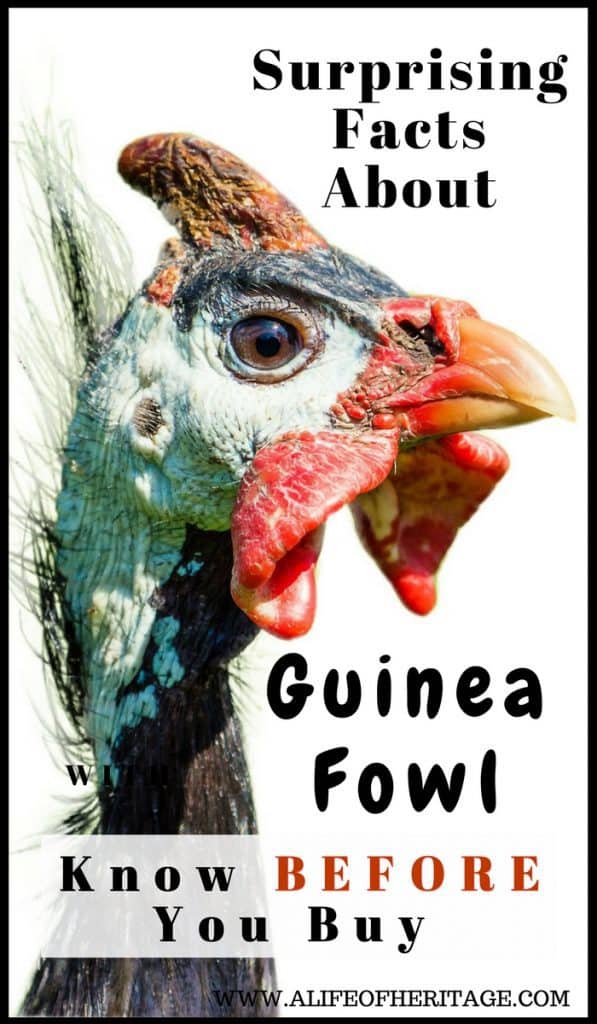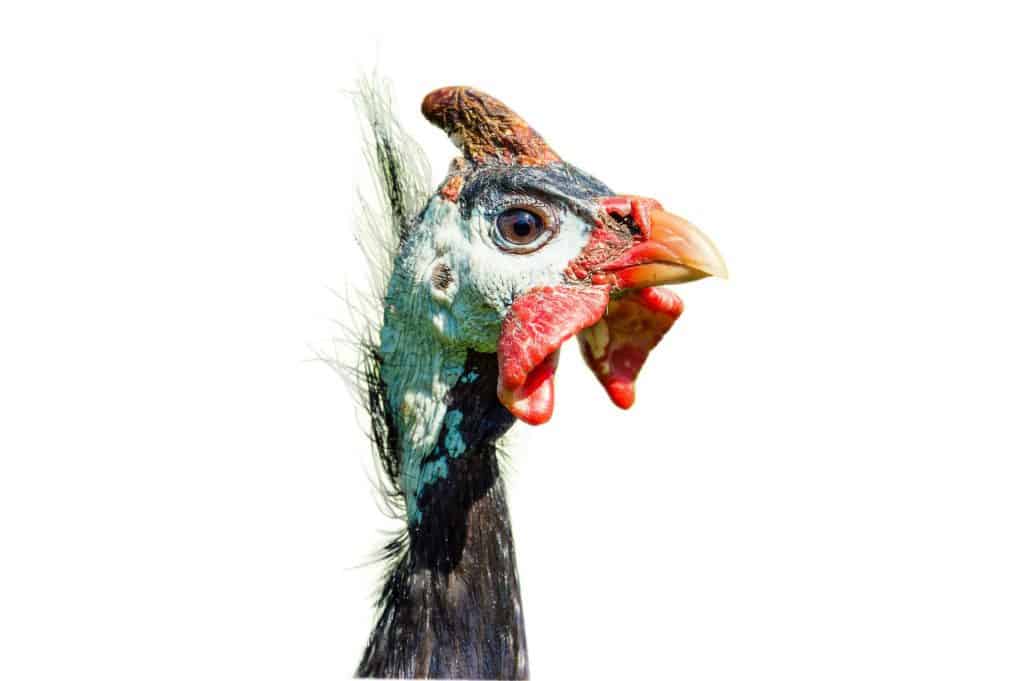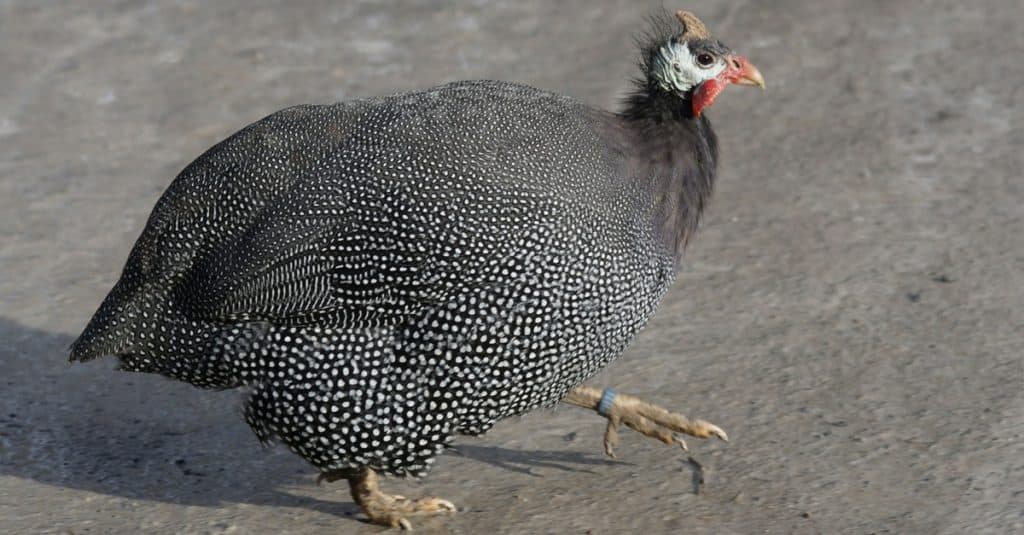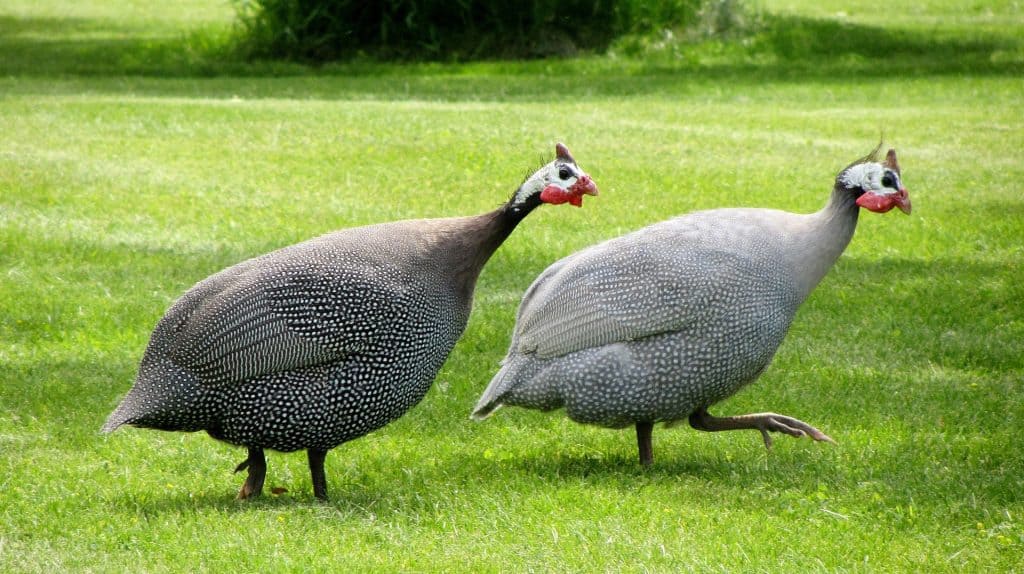Guinea Fowl are surprising and intriguing creatures and it’s best to know exactly what you are getting into before getting any. You will fall into one of two categories: you will either LOVE them or HATE them. Here’s why….
If you are serious about raising guineas, you will need this guide to help you: Complete Guide to Raising Guinea Fowl.
Guinea Fowl
I breathed in the slightly cool breeze and closed my eyes enjoying the break in the afternoon heat as I slid the box of corn in the back of my vehicle. My neighbor had too much corn and was passing some on to me! I couldn’t pass that up!
When I opened my eyes, they focused on two creatures, marching in cadence alone the fence line. I grinned. They were so…ugly.
And yet, kinda endearing.
Kinda.
In that “What am I thinking!?” sort of way.
“Yup. Those are my guineas. We really like them, they can be noisy but boy are they good bug eaters!”, my neighbor explained as she followed my line of sight.
We both stood there and watched. They walked with purpose. On a mission. Head bent down in a determined march against all things bugs.

There are two types of guinea owners:
- Those who own them and LOVE them.
- Or those who’ve owned them and HATE them and will never own one again.
If you do own any or plan to own any, you will fall into one of those two categories. Here’s why:

Guinea Fowl Sounds
So, there’s this thing about the noises that guinea fowls emit. They are, quite frankly, very noisy if they are disturbed.
Reasons a guinea fowl will make noise:
• New visitors to the property
• Visiting dogs
• Becoming separated from their guinea pals
• A horse running across the pasture
• And ANYTHING that they may deem to be unusual…the sky is falling…?
They are known to keep rodents off of properties because, well, even the rodents don’t like their noises! These guineas proudly display a “pugnacious disposition!”
The hen will make two-syllable sounds that sound like this:
- “buckwheat, buckwheat”
- “put-rock, put-rock”
- “qua-track, qua-track”
While the males will make a noise that sounds something like this:
- “kek-kek-kek”
- “chi-chi-chi”
You can find a lot of articles here on A Life of Heritage that will teach you a lot about poultry and be sure to check out GUINEA FOWL: Profitable Poultry Bundle–It’s FULL of to-do lists, checklists, record keeping sheets, and resource pages that will keep your flock healthy and YOU organized!
In excitement, both the hens and the cocks will make the one-syllable cry but the cock will never make the two-syllable noise. The young keets (guineas younger than 12 weeks old) will begin to make noises at 6-8 weeks but some of the females don’t start calling until they are much older.
Their noises, pecking, scratching, and wing flapping will usually scare away owls, raccoons, hawks, and any other enemy that might try to show up. (But they are quite blind at night, so those same enemies can quite easily pick them out of their roosts as they sleep.)
So depending on expectations, this ability to be the property watchdog, can be a bad trait or a really, really good trait!
Guinea Fowl Characteristics
Pecking order, anyone? Guineas take this to a whole new level. Many people claim that if kept with chickens, their chickens will begin to avoid the coop and nest boxes and they may begin to remove feathers off of sweet chicken derriere’s. This many times is the case even if chicks and keets are raised together.
Also, male guineas will terrorize roosters if kept in the same area full time. They will chase them and keep them from food and water. On short-term occasions, like during a blizzard or poor weather or if the chickens and guineas only spend time in the coop at night to roost, they can be housed together.

Can Guinea Fowls Fly?
Guineas are also very independent. They know no boundaries and can fly. Like 400-500 feet at a time, fly! And they are very, very fast. They are dumb enough to be caught by predators but fast enough to not be caught by you.
“Why did the chicken cross the road…?” No! NO! “Why did the GUINEA cross the road…?” That would be much more appropriate. Fences, boundaries, trees, roads? Means nothing to one of these birds! They seem to have retained their wild traits and usually are harder to tame and wilder and much more active than chickens.
Because of their insistence to cross the road…another predator is the vehicle. Many a guinea, in their treck for independence, have been smooshed by a passing car.
Guinea Fowl Breeding
Guineas are known to find a very secretive spot to lay their eggs and it is not uncommon for them to set on a nest of 30-40 eggs. And just went you were sad (or relieved?) that one was missing… after about 26-28 days, out she comes with a long trail of keets following behind. Sadly, she is immediately on the go and the keets aren’t ready for the wet, mud, and cold she is willing to drag them through. Many of them get chilled and die as a result.
Interestingly, guineas are native to Africa and are very sensitive to dampness in their first few weeks of life. But after they have passed that time frame, they are one of the hardiest of fowl there is.
In a natural environment, guineas will mate in pairs. But in a more confined environment, one male to every 4-5 hens is sufficient. And isn’t this sweet: the cocks and hens will both raise the keets together.
Another interesting fact is that it is impossible to sex guineas until they are older than 52 weeks. After that their differences can be noted in the sounds they make (mentioned above) and the size of their helmet and waddles. A males helmet and waddles will be noticeably larger in size.
And that lovely guinea cock can breed your chicken and produce hybrid offspring. A guinea fowl and a chicken cross are called a “guin-hen”. And if they breed a peafowl it is called a “pea-guinea.”
But for all their noise…and spunk…and desire to see the world at large…and proliferate…there are a few more attributes of the guinea fowl that can’t be overlooked.
Guinea Hen Eggs
Do guinea hens lay eggs every day?
Guinea hens usually start laying around March or April and can still be laying in October. Under close management, they can lay up to 100 or more eggs a year. Their eggs are smaller than chicken eggs and have a much thicker shell. And the weight of their eggs is about 1.4 oz compared to the 2 oz of a chicken egg.
Breeding hens will usually produce well for 2-3 years before being replaced and 4-5 years in a smaller farm flock setting. But they tend to go broody after laying about 30 eggs.
If you do find a clutch of eggs, mark 4-6 of the eggs and each day collect the unmarked eggs. *Usually* the hen will continue to lay in the same location if a few eggs are left. But if all the eggs are taken, she will find a new location to lay and you will be hunting eggs again!
Are Guinea Hen Eggs Edible?
Of course! Their eggs can be eaten and used just like a chicken egg. In fact, their taste will rival that of chickens! They have a larger yolk to white ratio and have a denser yolk. They also cook faster than chicken eggs. Their shells can almost be used in softball because they are so hard and the eggs are more pointy on one end. And many people find that they are excellent hard-boiled!
Guinea Fowl: Ticks and All Those Bugs!
Do Guinea Fowl Eat Ticks?
If you have a tick problem then Guineas should be your number 1 natural go-to for crowd control. They are excellent bug eaters.
They will eat a variety of insects and arachnids:
- Mosquitoes
- Ticks (They are used in some areas to reduce Lyme Disease!)
- Beetles
- Weed seeds
- Slugs
- Worms
- Caterpillars
- Ants
- Termites
- Wasps
- Grasshoppers
- Spiders
- Flies
- Crickets
- Boxelder Bugs
- Bees
But! If you have apiaries on your property, they are known to stand alongside the beehives and eat the bees as they come out of the hives! ~Source
Guinea Fowl and Snakes
Some areas (thankfully not mine!) have a problem with snakes eating eggs and baby chicks. And what do those pugnacious guineas do? They go out and find the snakes before they can even be a problem. Now, if that isn’t efficiency, I don’t know what is! So, yes, guineas can be an effective and efficient way of reducing snake problems. Go Guinea Go!
Guinea Fowl Meat
What does a guinea fowl taste like?
Guinea fowl meat tastes like wild game, much like pheasant meat tastes, and are a darker meat than a chicken. But the breast meat is white meat. And it is also leaner and drier than chicken meat but is also very tender if cooked properly. They also offer great ratio yields between meat and carcass: 50/50! Their meat also has 134 calories per 100 grams, which in comparison, a turkey has 109 calories per 100 grams. So there are many health benefits to eating guinea meat.
There are many people who absolutely love Guinea meat. In fact, it is considered fine dining in Europe. Restaurants will usually choose guinea meat over pheasant meat because they have fewer tendons in their legs, which makes that part of the bird more cost-effective and versatile.
They are ready to eat between 14 and 16 weeks.
What is the life expectancy of a guinea fowl?
Guineas can live for approximately 10-15 years. Unless you move into a hate relationship with them…then their life expectancy decreases drastically.
Their lifespan will be affected by local predators, breeding practices, how many keets they have raised, and if they are farmed for meat.
An adult guinea typically weighs between 3-3.5 pounds
Have you been convinced that a Guinea is just what the doctor prescribed? Let’s take a look at what it takes to keep them alive, because, you know, now you are in love with them and will do anything to protect them.
Do You Need a Coop for Guinea Fowl?
If you love your guineas, then yes, they will need a coop. They prefer to be wild and untamed and will perch on the tallest of trees on your property quite happily. And from that vantage point, they can see a better set of trees a 1/4 of a mile away and start roosting at night further and further away each time.
Oh, and remember their roaming capabilities? They might not come home at night if they aren’t given a coop with perches, perches as high as possible! And if they don’t come home at night they are more prone to the predators looking for a tasty snack or being caught in a storm. In colder climates, all animals and birds need to be able to get out of the wind, snow, and weather.
Some people have tried this and have even been successful at “training” their guineas to come in at night. It is easier to train them when they are young keets but the gist of training them is this:
Begin to let them out in the later afternoon so there is a shorter timeframe before dark. When it’s time to go back to the coop, utilize two long sticks and “herd” the birds into the coop.
As they grow, they may become more independent and the training will need to be more forceful. For instance, if they end up on the roof of the barn perching or the tree, then getting them down and making them come in is important. If they are allowed to keep staying out at that point they will keep staying out and will probably get farther and farther away from home.
As they get older, the time they are out of their coop gets longer and longer until they are out all day. If you are concerned and want them to return each night, give yourself enough time to go out each evening and make sure they are heading home and not finding a place to roost.
Another way to “train” the guineas to their new home is to let one guinea out the first week. It will learn its way around the property but won’t go far because they don’t like to be separated. Then the next week let out another bird, so there are two outside. If they stay close and don’t wander off, it is usually safe to let the others out the following week.
In a coop setting, because of their dominance, it is best to have several doors leading into the coop and larger doors so that the “door guard” guineas don’t keep others from entering the coop. These bossy and mean door guards are one more reason that guineas find a better place to roost outside. It will also be easy for you and the guineas if the doors are low and easily accessible.
Also, guineas don’t like to enter dark buildings. If possible, have a timer turn on a light about an hour before dark. This will give them enough light to make it into the coop and start perching before it’s completely dark outside. Clipping their wings may help in their ability to roost in the trees outside and may also encourage them to come in at night.
Putting out treats in the morning and evenings will also be alluring and enticing to these free-spirited birds and will give them a reason to come home in the evenings as well.
Guineas need approximately 2-3 square feet per bird and for the area to be well ventilated and have low moisture accumulation. They prefer to lay their eggs on the ground (not in a nest box) and in very secretive locations.
You can read more about training guineas to come home at night here.
Be sure to check out GUINEA FOWL: Profitable Poultry Bundle–It’s FULL of to-do lists, checklists, record keeping sheets, and resource pages that will keep your flock healthy and YOU organized!
What do You Feed Guinea Fowl?
Guineas, when left to their own devices during the spring, summer, and fall, will fend for themselves quite nicely and happily without eating much other than what they scrounge for. During the winter months, they can and will partake in a commercial poultry diet but the pelleted feed is not recommended. Feeding them mash or crumbles is best.
They do need fresh water at all times and providing grit and oyster shells are also important.
Also, it is best to feed them at these protein levels:
- Keets: 24% to 26% protein ration as the starter feed
- 5th-8th weeks: 18% to 20% protein ration
- 8th week and on: keets can be fed a 16% layer mash
During winter months especially, giving the guineas alfalfa hay and greens to peck at will benefit them immensely.
They do like these as an occasional treat (and these can be used as the enticing treat to lure them home at night):
- Wheat
- Sorghum (milo)
- Millet
What NOT to Feed Guinea Fowl
There are a few things that are important to note and NOT feed guineas.
- Larger grains (they don’t prefer it and will waste it)
- Whole kernel corn (definitely will not eat it)
- Medicated poultry diets (Coccidiostats, such as Coban, are TOXIC to guineas)
Guinea Fowl Health Management
Guineas are susceptible to the same health, parasite, and disease issues as poultry face and can be treated in the same way.
Hatching Guinea Hen Eggs
Guinea hens, in fact, make pretty poor mothers. If a broody hen is available they can sit on 20-28 eggs (a banty hen can sit on 12-15 eggs) and the chickens make much better mothers than the guineas.
Because of their very thick shells, it is impossible to candle before day 10. But other than this difference, guinea eggs can be incubated just like chicken eggs. You can find great hatching resources on our free resource page.
Brooding and Rearing Guinea Fowl
If keets are purchased online and mailed to you or if you have saved them from their mother, they need to be kept in a brooder starting with a temperature of 95°F (35°C) for the first two weeks and then lowered 5° each week until they are fully feathered. After that, they are an extremely hardy bird.
If using a heat lamp, hover the lamp between 18-24 inches above the keets, hanging it by a chain, not the cord. Make sure it is secured properly and tightly so as not to fall on the keets and start a fire. Watch the behavior of the birds. If they are huddled close together, they are too cold and if they are far away from the light, they are too hot. The light can be raised or lowered to a point where the keets are evenly dispersed in their brooder.
Guinea Fowl Terminology
There may have been a few words that were new and there wasn’t an explanation. So here is a list of terminology and their definitions associated with guinea fowl.
Guinea Fowl: Proper name of the species
Guinea Cockerel: A male guinea less than a year old
Guinea Cock: An adult male guinea a year or older
Guinea Pullet: A female guinea less than a year old
Guinea Hen: An adult female guinea a year or older
Guinea Keet: Offspring of a guinea hen and a guinea cock from hatch through 12 weeks of age
Young Guinea: Any guinea 12-52 weeks old
Helmet: Protuberance on the head of some guinea fowl
Wattles: Fleshy coral red appendages, flat, stiff and free from wrinkles, hang from either side of the head.
Poultry: Domestic fowl raised for meat or eggs
Varieties: Differences in color patterns or markings
Varieties of Guinea Fowl
The helmeted guinea fowl is the most common species and can be characterized by the boney “helmet” on top of their head and there are three varieties recognized by the American Poultry Association in their standard of perfection:
- Pearl
- Most popular
- Purplish-gray plumage with dots that resemble pearls
- Feathers used for ornamental purposes
- White
- Also called African White
- Pure white feathers
- Lighter skin
- Lavender
- Light gray or lavender plumage with white spots
- Similar to Pearl
Benefits of Raising Guineas
- They are great tick and bug control
- They keep snakes at bay
- Their noise and pugnaciousness keep predators away during the day
- They are easier on the garden than chickens and provide great pest control
- They proliferate
- They are oddly…cute
Cons of Raising Guineas
- They are loud
- They wander
- Prone to predators at night
- They proliferate
- They are wild
- They are quite…ugly
So there you have it. The definitive reasons to LOVE or HATE guinea fowl.
Which side are you on? 😉 Do you love ’em or hate ’em?
My friend over at A Free Range Life wrote a post about guineas that I chuckled the whole way through: 5 Reasons Not to Own Guineas
You can also earn income with poultry by Selling Hatching Eggs and Day Old Chicks

Anne
Friday 29th of April 2022
I have 4, and they are with my chicks I am also raising they get along good, my Guinea’s eat out of my hand and have yet to squawk at the deer or squirrels. My dogs also go in pin when I go 3 times a day and eat the feed with them I think I may have ruined my Guinea’s lol They are 7 weeks old
Delci Plouffe
Tuesday 10th of May 2022
This is awesome! I've found guineas to be the hardest birds to think I'm cool lol